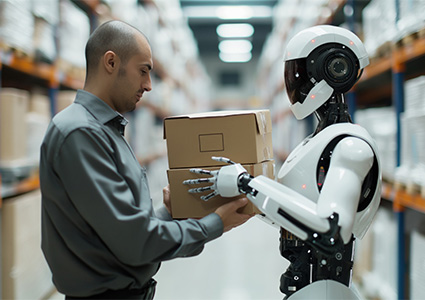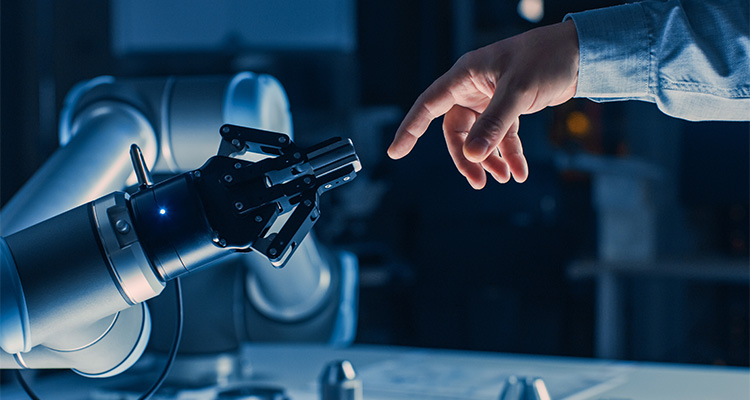Humanoid Robots in Warehouses: A Pilot Study Approach
The field of humanoid robotics has undergone rapid advancement in the last few years, and state-of-the-art humanoids are now sophisticated enough to provide tangible value in real-world settings. As we face a global labor shortage, organizations are turning towards automation of physical processes to fill the gap. Despite recent advancements, deployment of humanoids into warehouses and production facilities is not without potential friction and pitfalls. To mitigate risk, corporations should conduct pilot studies with humanoids before committing to full-scale deployment. Pilot studies also allow corporations to collect meaningful, quantifiable data about the implementation of humanoids within specific business functions, providing a tangible basis to make informed decisions.
 One of the most significant trends in humanoid robotics is the continuous advancement in both hardware and software – without sophisticated software, even the most advanced robotic hardware is just a collection of metal and plastic. Enhanced AI capabilities, including natural language processing and computer vision, enable robots to perform complex tasks, adapt to new environments, and interact with human counterparts. The integration of AI into robotic control systems has unlocked the ability for humanoids to learn from their experiences and perform higher level decision making, in turn, allowing for the completion of increasingly complex tasks. We have also seen significant progress on the hardware side. Innovations in motor and actuator design, along with improvements in energy storage and management, are pushing the boundaries of what humanoid robots can achieve.
One of the most significant trends in humanoid robotics is the continuous advancement in both hardware and software – without sophisticated software, even the most advanced robotic hardware is just a collection of metal and plastic. Enhanced AI capabilities, including natural language processing and computer vision, enable robots to perform complex tasks, adapt to new environments, and interact with human counterparts. The integration of AI into robotic control systems has unlocked the ability for humanoids to learn from their experiences and perform higher level decision making, in turn, allowing for the completion of increasingly complex tasks. We have also seen significant progress on the hardware side. Innovations in motor and actuator design, along with improvements in energy storage and management, are pushing the boundaries of what humanoid robots can achieve.
As advanced as humanoids have become, manufacturing them at meaningful scale is a significant challenge for startups. Humanoids often have a similar parts count to most electric vehicles (EVs), except in a much smaller frame. Manufacturing humanoids at scale requires sophisticated production capabilities, and it will take many years to scale manufacturing to meet the predicted demand for humanoids, which is in the many millions of units. Thus, large corporations with significant demand for humanoids may spend some time waiting for order fulfillment.
Even if humanoids were readily available at scale today, we would still advise organizations to conduct pilot studies before deploying them into the workforce. Pilot studies help organizations mitigate risks and uncertainties by providing valuable insights into the real-world performance of humanoids. However, conducting pilots in environments that closely mimic real-world conditions is crucial. This includes replicating the machinery, spacing, items or parcels, lighting, and even terrain found in operational warehouses.
During a pilot study, tracking key metrics will allow corporations to quantify humanoid productivity and cost. Some of the key metrics include process speed (e.g. PPH loaded onto a belt), error rates, onboarding and maintenance time, uptime and downtime, time required to charge or swap out batteries, energy utilization and cost, and so on. When evaluated as a whole, these metrics will allow organizations to holistically determine the efficacy and value of humanoids.
Performing a pilot study also allows organizations to work through any potential hiccups during the humanoid onboarding process, in a controlled setting. For example, it is critical to ensure seamless communication between a humanoid’s operating system and the WMS (Warehouse Management System) in use. WMS have become increasingly robust, taking on the role of a ‘warehouse brain’. Humanoids need to be able to communicate back and forth with a WMS to receive instructions and tasks, and it’s best to work through this prior to full-scale deployment. Another potential friction point lies in onboarding humanoids onto new tasks. No task set will be identical from organization to organization. Performing real-world tasks in a pilot study allows humanoids to collect organization-specific data and learn from their mistakes, increasing performance ahead of full-scale deployment.
Successful pilot studies with humanoid robots are already being conducted, showcasing their ability to perform complex tasks in commercial environments. Sanctuary AI, for example, successfully completed the first deployment of their humanoid, Phoenix, at a large retail chain store in Langley, BC, where it performed 110 retail-related tasks. This pilot demonstrated the robot’s ability to handle both front and back-of-store activities, allowing human employees to focus on higher-value tasks. Another company in the space, Agility Robotics, announced that Amazon will begin testing their robot, Digit, at its robotics research facility near Seattle. This collaboration builds on Agility’s existing relationship with Amazon, as the Amazon Industrial Innovation Fund had already made an investment into the company. Digit, designed for laborious warehousing work, will initially assist with tote recycling in Amazon warehouses, aiming to improve workplace safety and efficiency.
Sanctuary AI, for example, successfully completed the first deployment of their humanoid, Phoenix, at a large retail chain store in Langley, BC, where it performed 110 retail-related tasks. This pilot demonstrated the robot’s ability to handle both front and back-of-store activities, allowing human employees to focus on higher-value tasks. Another company in the space, Agility Robotics, announced that Amazon will begin testing their robot, Digit, at its robotics research facility near Seattle. This collaboration builds on Agility’s existing relationship with Amazon, as the Amazon Industrial Innovation Fund had already made an investment into the company. Digit, designed for laborious warehousing work, will initially assist with tote recycling in Amazon warehouses, aiming to improve workplace safety and efficiency.
The role of humanoid robots in warehouse operations is expected to expand significantly in the coming years. According to Goldman Sachs, the humanoid robotics market has the potential to reach $154 billion by 2035. As technology advances, humanoids will be able to perform a broader range of tasks, from simple, repetitive activities to complex tasks that require problem solving. As humanoid capabilities expand, pilot studies will allow businesses to train robots to their unique processes and use the collected metrics as a decision basis for wider rollout. In the coming years, the economics of deploying humanoid robots will also improve as startups achieve economies of scale in manufacturing.
Looking ahead, the potential for humanoid robots extends far beyond warehouse operations. We imagine a future where humanoid robots not only streamline industrial tasks, but also assist in disaster response, provide companionship and care in homes, and even contribute to scientific research in environments inhospitable to humans. The ongoing advancements in AI and robotics will likely yield robots that can adapt, learn, and even innovate alongside humans. This synergy between humans and robots has the potential to unlock unprecedented levels of productivity and worker satisfaction in our society, allowing human workers to move away from repetitive, strenuous tasks and towards more strategic workflows. As for how far away this imagined future is, the next few years of robotic development will be telling. In the meantime, while humanoids are still evolving rapidly, performing pilot studies is a low-risk way for corporations to explore real-world application ahead of full-scale deployment.
For a list of the sources used in this article, please contact the editor.
By Lucas Tesler
Lucas Tesler is an Associate at Silicon Foundry. Lucas works with Silicon Foundry’s Members to explore cutting-edge innovations in a variety of fields. Silicon Foundry, a Kearney company, is a global innovation advisory firm that catalyzes opportunities and accelerates change to push the frontier of what’s possible.
